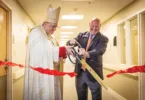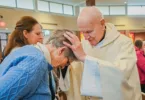
Dr. James Albers, a former youth minister and current senior pastor in Wichita, shared how to create a safe church environment with archdiocesan clergy, religious education directors and youth workers at a recent “Creating a Safe Church” seminar. LEAVEN PHOTO BY JOE MCSORLEY
by Jan Dixon
Special to The Leaven
LENEXA — “Protect our kids and walk them into a life of freedom.”
That was Deacon Dana Nearmyer’s opening prayer and the central message heard by archdiocesan clergy, religious education directors and youth workers at a recent “Creating a Safe Church” seminar.
“Creating a safe place for children, teenagers and adults in the church requires teamwork,” said Dr. James Albers, a former youth minister and current senior pastor of Celebration Baptist Church in Wichita.
His extensive theological training and 25-plus years of experience with children, teens and adults, have given him an insight into the joys and challenges of church work.
“God’s word doesn’t change,” he said. “But the methods by which we share God’s word have changed.”
In 2014, Pope Francis said communication is a means of spreading the mission of the entire church. Today, social media is one way.
“Although web-based mobile technologies enhance communication, learning and ministry,” Albers said, “they are very dangerous tools.”
It is therefore important that youth workers of the church recognize their responsibility to learn which platforms kids are using and to help them discern what is safe.
Youth ministers can also serve as a bridge for parents to understand what their kids are using.
Special Agent Mike Daniels of the FBI Child Exploitation Division explained the many dangers faced by young people online today: enticement, trafficking, pornography, sexting and sextortion.
“Social media provides many ways to perpetuate harm to victims,” he said.
Kids today prefer instant chat apps, but with a false sense of security in sending content to friends and strangers. The photos and videos disappear after viewing but viewers can screenshot and save content.
“With this false sense of security, kids can move beyond sharing silly photos to the world of sexting and sexual videos,” said Daniels.
Task force officer David Albers, of the Kansas City Police Department, gave real life examples of child exploitation cases to challenge the thinking of the conference attendees.
“The federal and state laws regarding child exploitation laws are severe,” he said. “The outcomes for all involved are tragic.”
And that is why child protection protocols must be in place.
Applications for volunteers, criminal background checks, reference checks, interviews and regular training sessions are proactive measures against the exploitation of children and are part of the Catholic Church’s Virtus program. It is required for anyone working with youth.
“Parents are also encouraged to sign up for Virtus online which has resources for everybody,” said archdiocesan youth ministry consultant Rick Cheek.
The need for a written and implemented child protection social media policy was given at the seminar. Key components should include a clear purpose, key definitions, a participation covenant, policy enforcement and a procedure for reporting suspected abuse.
Jan Saylor of the child and youth protection office of the archdiocese said the office is always available to answer questions and provide assistance with these protocols.
The presenters suggested that youth workers protect their ministry by avoiding the use of the ever- growing list of messaging apps as communication tools for ministry and keeping all communication with minors public.
It was noted that written consent from the parents/guardians must be received before posting any pictures of children under the age of 18. Tagging or captioning images with student names was strongly discouraged.
“We love God and we love people, and that’s why we implement child protection protocols,” said James Albers. “We are creating a safe church for children and teens and the people who work with them.”






